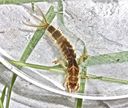Common Burrower Mayflies
Ephemeridae
Classification
- Phylum: Arthropoda
- Subphylum: Hexapoda
- Class: Insecta
- Order: Ephemeroptera
- Suborder: Furcatergalia
- Infraorder: Scapphodonta
- Superfamily: Ephemeroidea
- Family: Ephemeridae
Pronunciation
How to pronounce Ephemeridae: /ˌɛfəˈmɛrɪdiː/
These audio files are automatically generated. While they are not always 100% accurate, they are a good starting point.
Images






Summary
Ephemeridae is a family of mayflies characterized by large size and the ability to burrow in sediments. They play a significant ecological role in freshwater habitats and are found globally except in Australia and Oceania. They have about 150 described species, with several genera recognized.
Physical Characteristics
Size large; 10-30 mm; strongly divergent M and Cu veins in front wings; larvae have long cylindrical bodies, tapered at both ends, sharp mandibles that curve outward like tusks, long fringed antennae, three cauda (anal filaments); legs adapted for digging.
Identification Tips
Look for large mayflies with two or three long tails and distinctively patterned wings.
Habitat
Streams, lakes, and nearby areas; larvae burrow in sand and silt.
Distribution
Worldwide, except Australia and Oceania.
Diet
Nymphs are largely carnivorous, feeding through predation or scavenging.
Life Cycle
Ephemerids breed in a wide range of waters, usually requiring a layer of silt for the nymphs.
Ecosystem Role
Burrowing mayflies are important in aquatic ecosystems, providing food for fish and other predators.
Similar Taxa
Tags
- mayfly
- Ephemeridae
- aquatic insect
- freshwater ecosystem
- burrowing mayflies